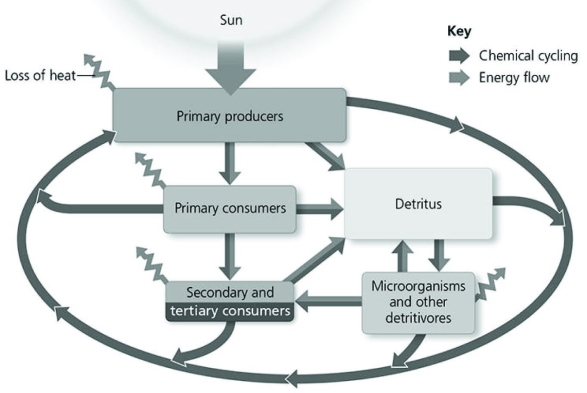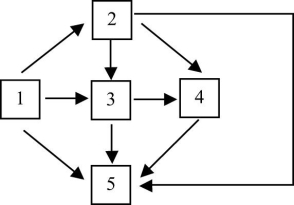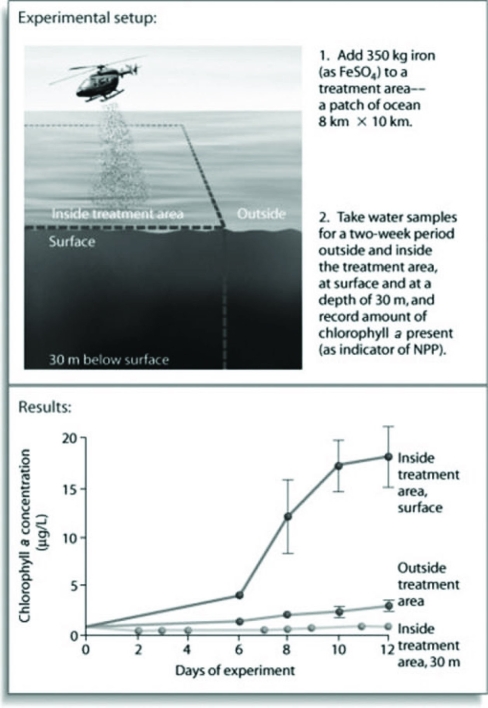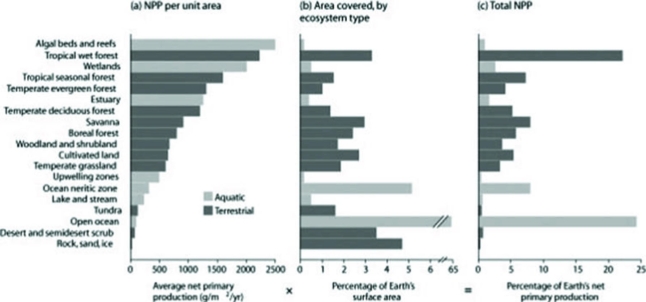A) replacing a ruined ecosystem with a more suitable ecosystem for that area
B) returning degraded ecosystems to a more natural state
C) managing competition among species in human-altered ecosystems
D) preventing further degradation by protecting an area with park status
Correct Answer

verified
Correct Answer
verified
Multiple Choice
Why is it that satellites, using wavelength reflectance technology, detect variable levels of productivity across latitudes in the Earth's oceans, rather than an increase approaching the equator?
A) Temperatures at the equator often exceed those which are optimal for primary production.
B) Light at the equator is too constant and direct.
C) NPP in Earth's open oceans could differ due to variability in depth, nutrients, the presence of coral reefs, or by ocean currents.
D) Satellites detect differences by measuring the amount of water vapor emitted by transpiring producers, and this is a variable measurement in the oceans.
Correct Answer

verified
Correct Answer
verified
Multiple Choice
Use the figure to answer the question:  Which of the following best explains why no arrows lead directly from "Detritus" to secondary consumers?
Which of the following best explains why no arrows lead directly from "Detritus" to secondary consumers?
A) detritus is living organic material, and primary consumers only eat dead organisms
B) few primary consumers directly eat detritus, and so it is mostly broken down into inorganic compounds by decomposers such as earthworms, fungi, and prokaryotes
C) detritus is toxic prior to being broken down by prokaryotes and fungi
D) detritus is too small to be located by primary consumers
Correct Answer

verified
Correct Answer
verified
Multiple Choice
Use the following figure to answer the question.  Food web for a particular terrestrial ecosystem (arrows represent energy flow and numbers represent species)
Which species in the food web most likely represents a primary producer?
Food web for a particular terrestrial ecosystem (arrows represent energy flow and numbers represent species)
Which species in the food web most likely represents a primary producer?
A) 1
B) 2
C) 3
D) 4
Correct Answer

verified
Correct Answer
verified
Multiple Choice
Which of the following best represents the actions of photoautotrophs?
A) produce oxygen and use carbon dioxide
B) produce, and use, both oxygen and carbon dioxide
C) produce thermal energy to be used by other organisms
D) convert chemical energy to solar energy
Correct Answer

verified
Correct Answer
verified
Multiple Choice
Which of the following components is not recycled within an ecosystem?
A) heat
B) nitrogen
C) phosphorus
D) carbon
Correct Answer

verified
Correct Answer
verified
Multiple Choice
The flow of energy in an example arctic ecosystem goes through a simple food chain as depicted below: Phytoplankton → zooplankton → fish → seals → polar bears Which of the following is the most accurate conclusion when considering the energetics in this food chain?
A) Polar bears could provide more biomass of food for humans than seals can.
B) The total biomass of the fish is lower than that of the seals.
C) Seal populations are larger than fish populations.
D) Fish can potentially provide more food for humans than seal meat.
Correct Answer

verified
D
Correct Answer
verified
Multiple Choice
Which of the following was a result of the Hubbard Brook watershed deforestation experiment?
A) Most minerals were not recycled within the intact forest ecosystem.
B) Calcium levels remained high in the soil of deforested areas.
C) Deforestation decreased water runoff.
D) The nitrate concentration in waters draining the deforested area became dangerously high.
Correct Answer

verified
Correct Answer
verified
Multiple Choice
Use the following figure to answer the question.  After looking at the evidence from the experiment in the figure, which of the following is the most accurate conclusion about productivity in marine ecosystems?
After looking at the evidence from the experiment in the figure, which of the following is the most accurate conclusion about productivity in marine ecosystems?
A) Nothing can be said based on this information.
B) Marine organisms break down iron for energy and thus for productivity.
C) Iron availability limits productivity.
D) Productivity increases when chlorophyll a is added.
Correct Answer

verified
C
Correct Answer
verified
Multiple Choice
If a pristine river valley was converted to a gravel mine, altering the stream channel and also impacting the associated aquatic and terrestrial biota, which of the following would most likely be the first step to restoring the former river valley ecosystem?
A) restore the physical structure of the river
B) restore native species that have been extirpated due to mining disturbance
C) remove competitive invasive species
D) remove toxic pollutants
Correct Answer

verified
Correct Answer
verified
Multiple Choice
Which of the following terms encompasses all of the others?
A) heterotrophs
B) herbivores
C) carnivores
D) primary consumers
Correct Answer

verified
Correct Answer
verified
Multiple Choice
Consider the food chain of grass → grasshopper → mouse → snake → hawk. About how much of the chemical energy fixed by photosynthesis of the grass (100 percent) is available to the hawk, assuming a 10% trophic efficiency?
A) 0.01%
B) 0.1%
C) 1%
D) 10%
Correct Answer

verified
Correct Answer
verified
Multiple Choice
The introduction of a predator population of arctic foxes to a small island caused the grassland community of the island to slowly convert to tundra due to changes in nutrient cycling. Which of the following best explains this change in the ecosystem?
A) The grassland habitats were negatively affected by the trampling and burrow-digging of the predator population.
B) The water intake of the predator population reduced water availability for grasses.
C) The predator population consumed a large proportion of the grass-like plants.
D) The predators consumed an herbivore or secondary consumer population that was promoting grass-like habitats.
Correct Answer

verified
Correct Answer
verified
Multiple Choice
Which of these ecosystems has the lowest net primary production per square meter?
A) a salt marsh
B) an open ocean
C) a coral reef
D) a tropical rain forest
Correct Answer

verified
Correct Answer
verified
Multiple Choice
Which of the following is a reason that inefficient transfer of energy among trophic levels results in the typically high endangerment status of many top-level predators?
A) Top-level predators often have small populations that are sparsely distributed.
B) Predators have relatively large population sizes.
C) Predators are more disease-prone than animals at lower trophic levels.
D) Top-level predators are more likely to be stricken with parasites.
Correct Answer

verified
A
Correct Answer
verified
Multiple Choice
Use the following figure to answer the question.  Which terrestrial habitat type in the figure makes available the most net biomass tissue per unit area available for consumers?
Which terrestrial habitat type in the figure makes available the most net biomass tissue per unit area available for consumers?
A) tropical wet forest
B) open ocean
C) algal beds and reefs
D) wetlands
Correct Answer

verified
Correct Answer
verified
Multiple Choice
The discipline that applies ecological principles to returning degraded ecosystems to a more natural state is known as ________.
A) restoration ecology
B) thermodynamics
C) eutrophication
D) biogeochemistry
Correct Answer

verified
Correct Answer
verified
Multiple Choice
The amount of energy from light (or chemicals, in chemoautotrophic systems) converted to the chemical energy of organic molecules per unit time is defined as ________.
A) net primary production
B) gross primary production
C) primary production
D) total photosynthetic production
Correct Answer

verified
Correct Answer
verified
Multiple Choice
Which of the following organisms is correctly paired with a trophic level?
A) cyanobacterium-secondary consumer
B) grasshopper-primary consumer
C) zooplankton-primary producer
D) grass-decomposer
Correct Answer

verified
Correct Answer
verified
Multiple Choice
Which statement best describes what ultimately happens to the chemical energy that is consumed but not used to produce new biomass in the process of energy transfer between trophic levels in an ecosystem?
A) It is undigested and winds up in the feces and is not passed on to higher trophic levels.
B) It is used by organisms to maintain their life processes through the reactions of cellular respiration.
C) Heat produced by cellular respiration is used by heterotrophs for thermoregulation.
D) It is eliminated as feces or is dissipated into space as heat as a result of cellular respiration consistent with the second law of thermodynamics.
Correct Answer

verified
Correct Answer
verified
Showing 1 - 20 of 80
Related Exams